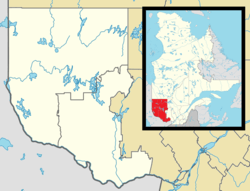Fort-Coulonge
| Fort-Coulonge | |
|---|---|
| Village municipality | |
|
Rue Principale in Fort-Coulonge. | |
 Location within Pontiac RCM. | |
 Fort-Coulonge Location in western Quebec. | |
| Coordinates: 45°51′N 76°44′W / 45.850°N 76.733°WCoordinates: 45°51′N 76°44′W / 45.850°N 76.733°W[1] | |
| Country |
|
| Province |
|
| Region | Outaouais |
| RCM | Pontiac |
| Constituted | December 15, 1888 |
| Government[2] | |
| • Mayor | Raymond Durocher |
| • Federal riding | Pontiac |
| • Prov. riding | Pontiac |
| Area[2][3] | |
| • Total | 3.20 km2 (1.24 sq mi) |
| • Land | 3.19 km2 (1.23 sq mi) |
| Population (2011)[3] | |
| • Total | 1,377 |
| • Density | 431.6/km2 (1,118/sq mi) |
| • Pop 2006-2011 |
|
| • Dwellings | 601 |
| Time zone | EST (UTC−5) |
| • Summer (DST) | EDT (UTC−4) |
| Postal code(s) | J0X 1V0 |
| Area code(s) | 819 |
| Highways | No major routes |
| Website |
www |
Fort Coulonge is a village in the Pontiac Regional County Municipality in western Quebec, Canada. Its population in 2006 was 1,600. It is also the francophone centre of the otherwise largely (57%) anglophone Pontiac MRC, with 79.6 per cent listing French as their mother tongue in the Canada 2006 Census.
Fort-Coulonge is known for the Félix-Gabriel-Marchand Bridge which is actually in neighbouring Mansfield-et-Pontefract.
Demographics
Population
| Canada census – Fort-Coulonge community profile | |||
|---|---|---|---|
| 2011 | 2006 | 2001 | |
| Population: | 1,377 (+1.4% from 2006) | 1,358 (-18.2% from 2001) | 1,661 (-3.2% from 1996) |
| Land area: | 3.19 km2 (1.23 sq mi) | 3.19 km2 (1.23 sq mi) | 3.19 km2 (1.23 sq mi) |
| Population density: | 431.6/km2 (1,118/sq mi) | 425.7/km2 (1,103/sq mi) | 520.6/km2 (1,348/sq mi) |
| Median age: | 44.7 (M: 44.2, F: 45.1) | 42.6 (M: 42.4, F: 43.1) | 37.6 (M: 37.2, F: 38.1) |
| Total private dwellings: | 601 | 676 | 695 |
| Median household income: | $35,329 | $39,007 | $31,757 |
| Notes: Includes corrections and updates for 2006. – References: 2011[3] 2006[4] 2001[5] | |||
| Historical Census Data - Fort-Coulonge, Quebec[6] | ||||||||||||||||||||||||||
|---|---|---|---|---|---|---|---|---|---|---|---|---|---|---|---|---|---|---|---|---|---|---|---|---|---|---|
|
|
| ||||||||||||||||||||||||
History

In the late 17th century the site was occupied, perhaps intermittently, by members of the d'Ailleboust family, who used "sieur de Coulonge" as a title. Accounts differ: the Commission de toponymie du Québec mentions Nicholas d'Ailleboust de Manthet, who wintered in that location in 1694;[1] Elizabeth Browne Losey says it was founded by the d'Ailleboust family 'as early as 1650'.[7] With the fall of New France it was abandoned. Before 1800 it was re-occupied by the North West Company, who gave it its present name. When the Hudson's Bay Company took over in 1821 it continued to be supplied from Montreal. Until 1828 it was the head post on the Ottawa River. The post engaged in farming as well as trading. After 1830, as the area became more settled, it became more like a general store. The post's 655-acre (2.65 km2) farm was sold in 1844. In 1855 the surviving store was sold to Thomas Taylor, its last clerk. The buildings were still standing in 1873 but by 1892 they had burned down.[7]
The trading post became the village of Fort-Coulonge situated several kilometres down river.
The region's first sawmill was built by George Bryson, Sr., in 1843. The first wooden chapel was built in 1873. It was destroyed by fire and replaced by a brick church in 1884. In 1886, the railway reached Fort-Coulonge. Fort-Coulonge became a municipality in 1888 and John Bryson was the first mayor.
See also
- List of village municipalities in Quebec
- Coulonge Chutes
- Esprit Lodge - white water rafting training and certification.
- Pontiac Pacific Junction Railway and Cycloparc PPJ - former railway now converted into a bike path
References
- 1 2 Reference number 23187 of the Commission de toponymie du Québec (French)
- 1 2 "Fort-Coulonge". Répertoire des municipalités (in French). Ministère des Affaires municipales, des Régions et de l'Occupation du territoire. Retrieved 2012-04-02.
- 1 2 3 "Fort-Coulonge census profile". 2011 Census of Population. Statistics Canada. Retrieved 2012-04-02.
- ↑ "2006 Community Profiles". Canada 2006 Census. Statistics Canada. March 30, 2011. Retrieved 2013-05-12.
- ↑ "2001 Community Profiles". Canada 2001 Census. Statistics Canada. February 17, 2012. Retrieved 2012-04-02.
- ↑ Statistics Canada: 1996, 2001, 2006, 2011 census
- 1 2 Elizabeth Browne Losey, "Let Them be Remembered:The Story of the Fur Trade Forts", 1999.
- Elections Canada Results - 39th General Election (2006)
- Director General of Quebec Elections
- Official Transport Quebec Road Map
External links
| Wikimedia Commons has media related to Fort-Coulonge. |
- Fort-Coulonge (official site; English version)
- CHIP-FM Radio
 |
Mansfield-et-Pontefract |  | ||
| Ottawa River / |
|
Mansfield-et-Pontefract (Litchfield) | ||
| ||||
| | ||||
| Mansfield-et-Pontefract |